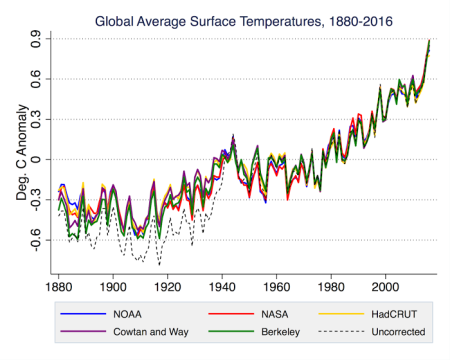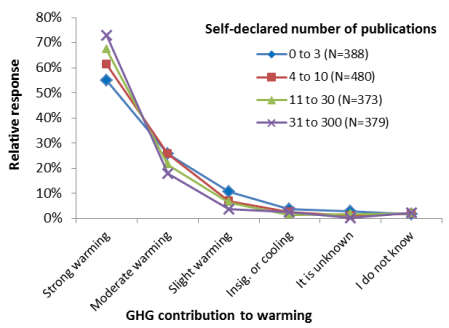(Zie de Nederlandse versie door Jos Hagelaars op ons Klimaatverandering blog)
The documentary “The uncertainty has settled” from Dutch filmmaker Marijn Poels follows him on his journey in rural Austria and Germany to witness how energy policies impact traditional agriculture. That is the stepping stone to also look into different ideas about how and why the climate is changing. Unfortunately Poels has no clue how to distinguish fact from fiction, and by his own admission he has no interest in making that distinction. As a result the documentary offers a mix of basic scientific insights, plain falsehoods, and misleading statements regarding climate science. As an unwitting viewer you are left utterly confused –cued by Poels’ facial expression at those times- how to reconcile these seemingly opposing viewpoints. Creating confusion was apparently his objective (as he acknowledges on his website), but it makes for a surreal experience if you know you’re being fooled. I think spreading falsehoods is doing a disservice to the public, as I’ve said to Marijn Poels during a radio-debate (in Dutch).
Let’s look more closely at some of the things being said about climate change in the documentary.
Marijn Poels meets another Dutchman in rural Germany, who laments how climate policies have led to the disappearance of local nature. He says it’s insane to think that a CO2 concentration as low as 0.035% (currently 0.04%) could have any impact on climate. That’s clearly fallacious reasoning (argument from incredulity): there are plenty of examples of compounds that have serious impacts at the same or lower concentrations (e.g. a CO detector will sound the alarm at such a concentration and you had better leave the premises). Without any CO2 in the air the globe would quickly become a frozen ball of ice, since the main air constituents (nitrogen 78%, oxygen 21%, argon 1%) don’t impede the infrared heat loss to space.
Later in the documentary he meets with climate scientist Hans von Storch, astrophysicist Piers Corbyn and physicist Freeman Dyson. Those in the loop will immediately recognize that this is not at all a fair representation of the scientific debate, but rather provides a very skewed vision thereof by emphasizing outlier views that are demonstrably false.

Hans von Storch accurately describes our current knowledge about climate change: We know that the earth has warmed and we can’t explain this warming without considering the human-induced increase in greenhouse gases in the atmosphere. He also distinguishes how scientific knowledge may be very uncertain in specific details, while the core tenets are robustly known: “The fact that CO2 has a significant influence on climate is indisputable.”
It’s astonishing how many falsehoods and conspiracy theories Piers Corbyn mentions over the course of few minutes. Some of the things he said:
FALSE: The increasing CO2 concentration in the atmosphere is coming from the oceans
If Corbyn were right, the concentration in the ocean should have decreased in order to explain the increased atmospheric concentration (a simple consequence of conservation of mass). However, CO2 concentrations have been observed to increase both in the atmosphere and in the ocean. In reality, the excess CO2 in both atmosphere and ocean originates from fossil fuel burning, as is evident from the isotopic signature and the concomitant decrease in atmospheric O2 concentration.
FALSE: CO2 only follows temperature
During the ice age cycles CO2 acted as an amplifying feedback on the warming which was initiated by changes to the earth’s orbit. During those times of relatively slow warming the temperature indeed started to increase before the CO2 concentrations did, after which the CO2 caused even more warming. Hence it’s a bit of a chicken-egg issue with CO2 and temperature, but Corbyn’s statement is misleading. The current CO2 increase is unequivocally anthropogenic and ~100 times faster than it was in glacial to interglacial transitions. Moreover, we have known since the mid-nineteenth century that CO2 absorbs infrared radiation and thus acts as a greenhouse gas which impedes planetary heat loss and thus warms up the surface.
FALSE: Termites produce more CO2 than human activity does
Termites produce less CO2 than human activity does. Moreover, while anthropogenic emissions have led to the increased CO2 concentration, there’s no sign of tremendous changes in termite populations or emissions. In general, CO2 uptake and release by the biosphere (through assimilation and respiration/decomposition, respectively) approximately balance over multi-annual timescales. Termites also emit methane, another greenhouse gas, though around 40 times less than is released through human activity. [Text about termite emissions has been updated 17-07]
FALSE: A new mini-ice age cometh
Corbyn has been predicting this for a while now (at least since 2010), but reality so far has been going in the opposite direction compared to his predictions. Scientists have investigated the potential consequences of a quieter sun in the near future, but generally find that increased greenhouse gas concentrations will dwarf any realistic decrease in solar activity, and hence the globe will continue to warm for the foreseeable future.
CONSPIRACY THEORY: The increased temperatures are a result of fraud with the observations
Globally averaged temperatures are computed independently by a number of different research group and they all agree within a close margin of each other. The raw data are available, so everyone who’s interested and who has the requisite skill can try to reproduce (or falsify) these calculations. A number of ‘skeptical’ people have indeed done so, and lo and behold, they found the same result: the globe really is warming.
Corbyn continues with his conspiracy theories and doesn’t even seem bothered that they’re mutually inconsistent with each other: on the one hand he claims that the ‘climate ideology’ has been made up by international big business interests, on the other hand he also claims that the ‘myth of climate change’ is a scheme to de-industrialize the West. How can you possibly take someone like this seriously?
Next up is renowned physicist Freeman Dyson, who is very skeptical of the ability of climate models to make accurate projections of future warming. In the documentary he paints a false dichotomy between observations on the one hand and models on the other hand, whereas in modern science they really go hand in hand and models form an integral part of science. Model simulations agree very well with observations, despite Dyson’s claims to the contrary. For good measure he also throws in a conspiracy theory by claiming that climate modelers only want to scare people, because they wouldn’t get money for their research otherwise. This goes to show that otherwise brilliant people can still make silly claims about a field of science that they don’t know much about.
So why did Marijn Poels chose to interview people who are demonstratively wrong (and who are not actually climate scientists)? His whole idea with the documentary was as a personal quest in which he listened to various viewpoints without judgment or evaluation. In a radio-debate I did with him on Dutch Radio NPO1 he proclaimed that he doesn’t feel any responsibility to figure out who’s talking sense and who’s talking nonsense. On twitter he has since confirmed that he doesn’t care what true and what’s not. I find that a very strange attitude for a documentary-maker, as I tried saying at the end of the radio-debate:
Scientists are seeking a better understanding of the world around us. What I hear Marijn Poels say is that it doesn’t matter to him what’s true and what’s not. That goes against everything I value as a scientist.
He also tweeted that “if there are multiple scientific perspectives, then it’s worthy of debate”. So the problem is not only that he doesn’t care about whether something is true or not; he doesn’t see that some of what he calls “scientific perspectives” are plain untruths. Claiming that the CO2 might just have come out of the ocean is no more a ‘scientific perspective’ than claiming that vaccines cause autism or that smoking is not linked to cancer. Science has conclusively shown these statements to be false.
In a public debate about smoking regulation there’s no point in discussing whether smoking is really bad for you: we know that by now, based on scientific evidence.
Likewise, in a public debate about climate policies there’s no point in discussing whether CO2 really contributes substantially to climate change: we know that by now, based on scientific evidence.







